NASA InSight – “Studying the Inner Space of Mars”
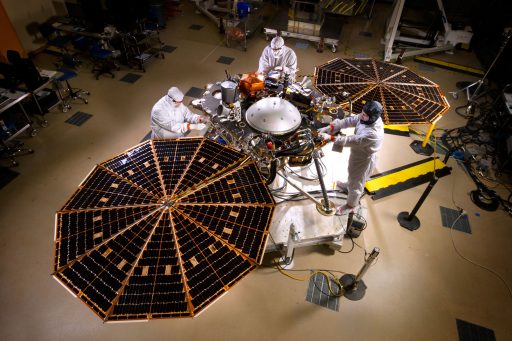
InSight is a robotic Mars lander designed and operated by NASA’s Jet Propulsion Laboratory as the first mission dedicated to a comprehensive study of the interior and subsurface of Mars through a suite of instruments including a high-fidelity seismometer and a burrowing heat probe.
It is the first outer space mission designed for an in-depth study of the interior of another rocky planet and will deliver valuable knowledge on the internal structure of Mars, shedding light on the formation of rocky planets in the inner solar system as well as rocky exoplanets and their evolution.
Probing the internal structure of Mars is hoped to bring new knowledge on the Solar System’s terrestrial planets – Mercury, Venus, Earth and Mars as well as Earth’s Moon – to better understand the processes responsible for shaping the rocky planets more than four billion years ago and transforming them into the worlds we explore today.
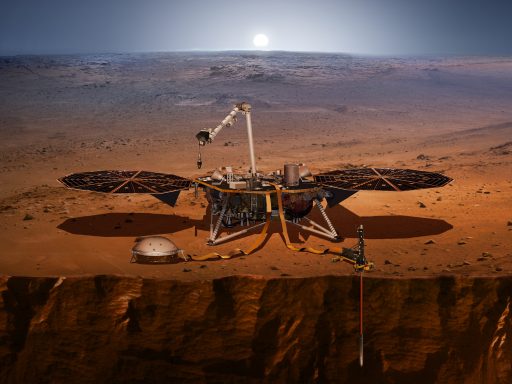
InSight’s primary task will be determining the overall structure of Mars’ core, mantle & crust and measuring the rate at which heat escapes from its interior – allowing a detailed evolutionary roadmap to be developed by scientists and providing valuable information on the differentiation processes that shaped the inner planets since their formation.
The InSight Mission aims to deliver a 360-Kilogram Lander to the surface of Mars for a two-year primary mission with a suite of three primary instruments to delve deep beneath the planet’s surface and measure its seismology, heat flow and rotation with unprecedented precision. InSight is a backcronym for “Interior Exploration using Seismic Investigations, Geodesy and Heat Transport.” Also involved in the mission are the first two CubeSats to operate beyond Earth Orbit – following InSight to Mars to relay communications during its critical Entry, Descent and Landing Phase toward the chosen Elysium Planitia landing spot.
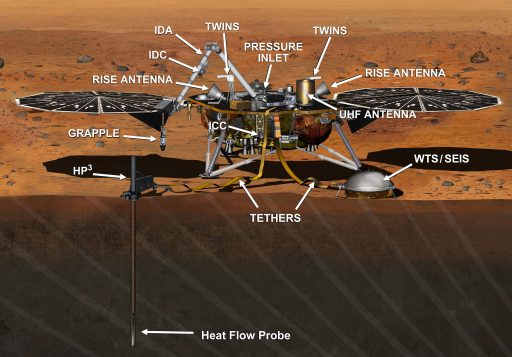
InSight was selected as a mission in 2012 and is flying under NASA’s Discovery Program for lower-cost Solar System Exploration Missions coming with lighter price tags than the agency’s New Frontiers or Flagship missions. Manufactured by Lockheed Martin Space Systems, InSight largely builds on the successful Mars Phoenix Lander that touched down successfully in March 2008 and operated for 157 sols to assess the present environment on Mars.
The InSight mission had an initial budget of $675 million and was targeting a March 2016 liftoff atop a United Launch Alliance Atlas V rocket from Vandenberg Air Force Base in California, becoming the first interplanetary launch from the site. However, a persistent problem with the main scientific instrument of the lander, the CNES-developed Seismometer, forced the launch to be delayed by 26 months to the next available interplanetary launch window in May 2018 – requiring an additional $155 million in spending, incurred as a result of the delay.
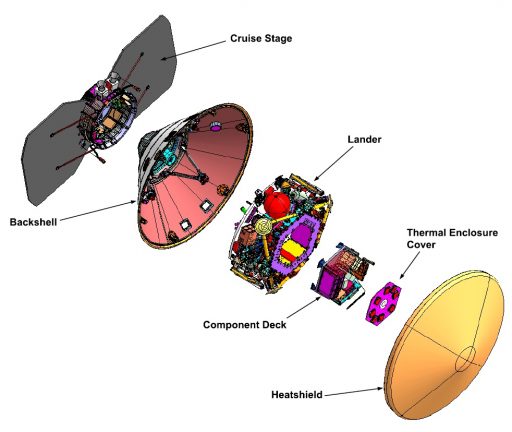
Realigned for the 2018 planetary launch window, InSight is targeting launch on May 5th (window through June 8th) and is expected to arrive at its destination on November 26, covering 484 million Kilometers over the course of its half-year cruise. The mission involves three international space agencies in institutions that developed the craft’s instrumentation and the science team comprises members from ten countries, working under principal investigator W. Bruce Banerdt and project manager Tom Hoffman.
The InSight instrument suite is headed by the Seismic Experiment for Interior Structure (SEIS), a highly sensitive seismometer developed by the French Space Agency CNES and a number of participating institutions with the goal of measuring Marsquakes and other internal activity to resolve the planet’s history & interior structure and explore phenomena like atmospheric waves, tidal forces from Mars Moon Phobos and high-frequency seismic activity. A meteorological and magnetometer suite collects weather data to add to a record of Martian environmental parameters but also provides important correction data for SEIS to subtract atmospheric disturbances from its data – a lesson learned from the Viking missions of the 1970s.
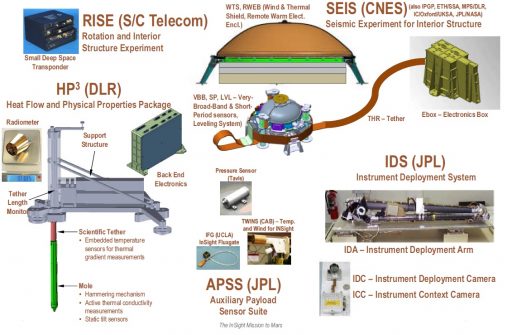
The Heat Flow and Physical Properties Package HP³, developed at the German Aerospace Center, features a self-hammering heat flow probe – nicknamed the mole – tasked with burrowing up to five meters into the surface to collect the first-ever measurement of the heat flow coming from the Martian core to reveal the planet’s thermal history – one of the fundamental pieces of information sought by geologists when looking at a planetary body and its evolution.
The JPL-developed Rotation and Interior Structure Experiment RISE will employ the lander’s X-Band radio to obtain precise measurements of Mars’ rotation period which, when coupled with similar measurements from Viking and Mars Pathfinder, will permit a fairly precise determination of the planet’s spin axis direction, precession and nutation amplitude and so constrain the size and density of the Martian core and mantle, also revealing with certainty whether the core is liquid or solid.
Additional instrumentation riding on InSight includes a meteorology suite to provide continuation of a Mars surface climate record (plus novel infrasound measurements), a Laser Retroreflector that would allow InSight to serve as a passive ranging target long after the end of its mission, and a pair of cameras to document the deployment of the instruments and to collect stereoscopic color imagery of the lander’s immediate surroundings. InSight’s main instruments are supported by a 2.4-meter long Instrument Deployment Arm that will deploy SEIS and HP³ to the surface.
